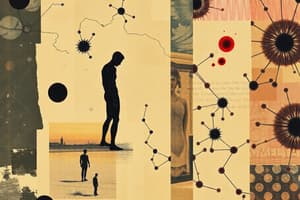Podcast
Questions and Answers
What was the primary focus of James Till's early research efforts?
What was the primary focus of James Till's early research efforts?
- Development of medical imaging techniques
- Radiation treatment (correct)
- The genetic structure of plant cells
- Therapeutic uses of hormones
What pioneering work did Till and McCulloch accomplish in 1961?
What pioneering work did Till and McCulloch accomplish in 1961?
- Clarification of the structure of DNA
- Development of a new chemotherapy drug
- Discovery of unspecialized cells in mouse bone marrow (correct)
- Identification of cancer-causing agents in the bloodstream
What recognition did James Till receive in 1969?
What recognition did James Till receive in 1969?
- Fellowship of the Royal Society of Canada (correct)
- Nobel Prize in Physiology or Medicine
- Presidential Medal of Freedom
- Lavoisier Medal for scientific achievement
Which of these areas was not a research interest of James Till later in his career?
Which of these areas was not a research interest of James Till later in his career?
What major discovery regarding stem cells did Till and McCulloch make?
What major discovery regarding stem cells did Till and McCulloch make?
Flashcards are hidden until you start studying
Study Notes
Early Life and Education
- James Till was born and raised in Lloydminster, Saskatchewan, Canada.
- Earned a scholarship to study physics at the University of Saskatchewan
- Till obtained a PhD in biophysics from Yale University in 1957
Professional Career
- Till became a research fellow at the University of Toronto after completing his PhD
- In 1958, he partnered with Ernest McCulloch at the Ontario Cancer Institute for research
- Till's focus shifted to cancer treatment, research ethics, patient quality of life, and the Internet's role in supporting patients
Contributions and Discoveries
- Till and McCulloch co-authored a paper in 1961 outlining the susceptibility of mouse bone marrow cells to radiation.
- This discovery led to further exploration of stem cells
- Their research unveiled the existence of undifferentiated cells, now known as adult stem cells, residing in the inner marrow.
- These adult stem cells can transform into any type of blood cell
Recognition
- Till was recognized as a Fellow of the Royal Society of Canada in 1969
- Received the Albert Lasker Award for Basic Medical Research in 2005, shared with Ernest McCulloch for their pioneering stem cell research.
Studying That Suits You
Use AI to generate personalized quizzes and flashcards to suit your learning preferences.




